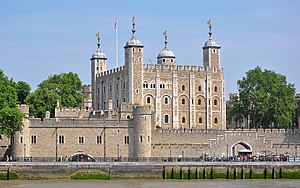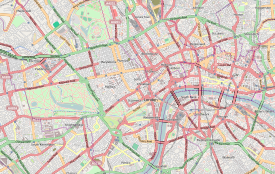Tower of London
| Tower of London | |
|---|---|

The Tower of London, seen from the River Thames, with a view of the water-gate called "Traitors' Gate"
|
|
| Location |
London Borough of Tower Hamlets London, EC3 United Kingdom |
| Coordinates | 51°30′29″N 00°04′34″W / 51.50806°N 0.07611°WCoordinates: 51°30′29″N 00°04′34″W / 51.50806°N 0.07611°W |
| Area | Castle: 12 acres (4.9 ha) Tower Liberties: 6 acres (2.4 ha) |
| Height | 27 metres (89 ft) |
| Built | White Tower: 1078 Inner Ward: 1190s Re-built: 1285 Wharf expansion: 1377–1399 |
| Visitors | 2,785,249 (in 2015) |
| Owner | Queen Elizabeth II in right of the Crown |
| Type | Cultural |
| Criteria | ii, iv |
| Designated | 1988 (12th session) |
| Reference no. | 488 |
| Country | United Kingdom |
| Region | Europe and North America |
|
Listed Building – Grade I
|
|
|
Listed Building – Grade II
|
|
The Tower of London, officially Her Majesty's Royal Palace and Fortress of the Tower of London, is a historic castle located on the north bank of the River Thames in central London. It lies within the London Borough of Tower Hamlets, separated from the eastern edge of the square mile of the City of London by the open space known as Tower Hill. It was founded towards the end of 1066 as part of the Norman Conquest of England. The White Tower, which gives the entire castle its name, was built by William the Conqueror in 1078, and was a resented symbol of oppression, inflicted upon London by the new ruling elite. The castle was used as a prison from 1100 (Ranulf Flambard) until 1952 (Kray twins), although that was not its primary purpose. A grand palace early in its history, it served as a royal residence. As a whole, the Tower is a complex of several buildings set within two concentric rings of defensive walls and a moat. There were several phases of expansion, mainly under Kings Richard the Lionheart, Henry III, and Edward I in the 12th and 13th centuries. The general layout established by the late 13th century remains despite later activity on the site.
The Tower of London has played a prominent role in English history. It was besieged several times, and controlling it has been important to controlling the country. The Tower has served variously as an armoury, a treasury, a menagerie, the home of the Royal Mint, a public record office, and the home of the Crown Jewels of England. From the early 14th century until the reign of Charles II, a procession would be led from the Tower to Westminster Abbey on the coronation of a monarch. In the absence of the monarch, the Constable of the Tower is in charge of the castle. This was a powerful and trusted position in the medieval period. In the late 15th century the castle was the prison of the Princes in the Tower. Under the Tudors, the Tower became used less as a royal residence, and despite attempts to refortify and repair the castle its defences lagged behind developments to deal with artillery.
...
Wikipedia

